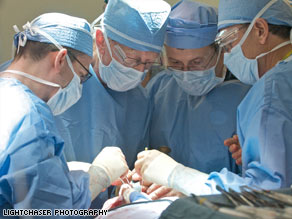
Doctors at a Boston hospital expressed optimism Friday that a man not yet fully awake after undergoing the second partial face transplant in the nation would recover fully.
“The operation is now over, but the healing has just begun,” Dr. Bohdan Pomahac, the chief plastic surgeon on the team, told reporters about the 17-hour procedure, which took place Thursday at Brigham and Women’s Hospital. “He has not seen himself yet.” Surrounded by more than two dozen medical personnel, many of whom participated in Thursday’s procedure, Pomahac said the man who received the graft had lost the bony structures of his mid-face, including his nose, hard palate and overlying soft tissues, such as the upper lip. Though the man’s injuries were not considered life-threatening, they were extensive. “This is not a life-saving, but this is a life-giving procedure,” Pomahac said. “It’s really difficult to live without a major part of the face — the social interactions, the ability to eat, drink, the ability to talk — all those are severely impaired.” First a donor was identified — matched for tissue characteristics and approximate age and skin color.
Don’t Miss
Face transplant patient regains self-confidence
Surgery transplanted most of patient’s face
Chimp attack victim remains in critical condition
Then, two operating rooms were set up — one for the donor and one for the recipient, neither of whom has been identified publicly. In a six-hour procedure, some of the seven plastic surgeons involved in the case recovered the donor’s tissues, including the muscles needed to make facial expressions, the nerves that power those muscles and the nerves that provide sensation, Pomahac said. The tissue was then taken to the other operating room, where surgeons looking through a microscope painstakingly connected the tissues to the recipient’s face. “It takes a lot of time to inset the facial part, make sure that the bony structure fits, that the nerves are connected, the skin is trimmed, of course, the whole graft remains well-perfused,” Pomahac said. Clotting and infection are two major concerns. The chief of the hospital’s face-transplant unit predicted that any clotting problems in the vessels connecting the graft tissue to the recipient’s face would most likely surface within 24 hours. Signs of infection caused by immunosuppression — induced to keep the recipient’s immune system from rejecting the donor’s graft and required for the life of the transplant — would be most likely to occur within the first week to 10 days, he said. Still, “rejection is always a concern and we’ll have to monitor very, very closely,” Pomahac said. If it were to occur, it could lead to the loss of the facial part, he said. It is unlikely that the recipient’s face will wind up looking like the donor’s, and there is a 60 percent chance that he will look “very like” he did before his injury, Pomahac said. The major risks associated with the procedure were made clear to the recipient through a process of informed consent that took years, the doctor said.
Health Library
MayoClinic.com: Organ donation — Don’t let these 10 myths confuse you
Prior to the operation, the recipient was seen by several psychiatrists — involved in the study and independent from it — and he will continue to see psychiatrists regularly, Pomahac said. Kevin O’Connor, vice president of the New England Organ Bank, read a statement from the donor’s family, which said in part, “The fact that we were able to give this gift was a tremendous comfort in our time of need. Our greatest hope is that this encourages others to become donors.” In December, doctors at the Cleveland Clinic in Ohio performed what they called a near-total face transplant. A woman received her new face in one graft from a donor cadaver. Two months later, the patient’s doctor said she was able to breathe through her nose, smell, eat solid foods and drink from a cup. Similar procedures have been performed in China and France.